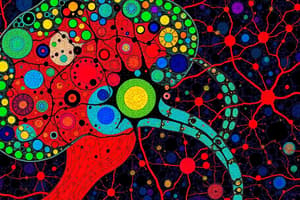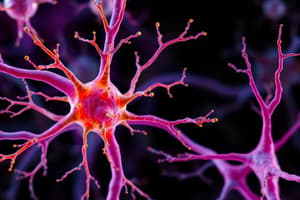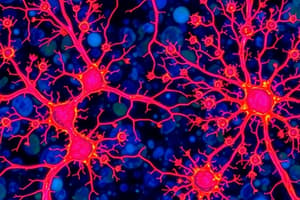Podcast
Questions and Answers
Which structure is part of the central nervous system (CNS)?
Which structure is part of the central nervous system (CNS)?
- Ganglia
- Brain (correct)
- Spinal nerves
- Cranial nerves
Which of these is considered part of the peripheral nervous system (PNS)?
Which of these is considered part of the peripheral nervous system (PNS)?
- Brain
- Cerebellum
- Cranial nerves (correct)
- Spinal cord
What is the main function of nerve cells (neurons)?
What is the main function of nerve cells (neurons)?
- To protect the brain from injury
- To occupy the interneuronal space
- To create a microenvironment suitable for neuronal activity
- To transmit nerve impulses (correct)
Which of the following is a function of neuroglia?
Which of the following is a function of neuroglia?
Which of these is a component of a neuron?
Which of these is a component of a neuron?
Which part of the neuron contains the nucleus?
Which part of the neuron contains the nucleus?
What is the main characteristic of the nucleus found in the cell body of a neuron?
What is the main characteristic of the nucleus found in the cell body of a neuron?
Where are Nissl bodies NOT found in a neuron?
Where are Nissl bodies NOT found in a neuron?
What is the function of Nissl bodies?
What is the function of Nissl bodies?
What is the primary function of the Golgi apparatus in a nerve cell?
What is the primary function of the Golgi apparatus in a nerve cell?
Where are mitochondria found in a neuron?
Where are mitochondria found in a neuron?
What best describes the number of axons a neuron typically has?
What best describes the number of axons a neuron typically has?
Which of these best describes the number of dendrites a neuron typically has?
Which of these best describes the number of dendrites a neuron typically has?
What is the function of the axon?
What is the function of the axon?
What is the main function of dendrites?
What is the main function of dendrites?
Which type of neuron has one process that divides into an axon and a dendrite?
Which type of neuron has one process that divides into an axon and a dendrite?
Where are bipolar neurons found?
Where are bipolar neurons found?
Which type of neuron is characterized by many dendrites and no axon?
Which type of neuron is characterized by many dendrites and no axon?
What is a key function of anaxonic neurons?
What is a key function of anaxonic neurons?
Which of the following is a type of neuroglia?
Which of the following is a type of neuroglia?
Which neuroglia cell produces myelin in the central nervous system (CNS)?
Which neuroglia cell produces myelin in the central nervous system (CNS)?
Which cells produce myelin in the peripheral nervous system (PNS)?
Which cells produce myelin in the peripheral nervous system (PNS)?
What main function do astrocytes have?
What main function do astrocytes have?
What is the function of microglia?
What is the function of microglia?
Which cells sheath axons in the peripheral nervous system?
Which cells sheath axons in the peripheral nervous system?
What is a characteristic of myelinated nerve fibers?
What is a characteristic of myelinated nerve fibers?
What forms the myelin sheath around axons in the peripheral nervous system?
What forms the myelin sheath around axons in the peripheral nervous system?
What is a key feature of unmyelinated nerve fibers?
What is a key feature of unmyelinated nerve fibers?
Which of the following surrounds the entire nerve from the outside?
Which of the following surrounds the entire nerve from the outside?
Which of the following surrounds bundles of nerve fibers?
Which of the following surrounds bundles of nerve fibers?
Which of the following surrounds individual nerve fibers?
Which of the following surrounds individual nerve fibers?
What are ganglia?
What are ganglia?
What type of ganglia are craniospinal ganglia?
What type of ganglia are craniospinal ganglia?
Which of the following describes the autonomic ganglia?
Which of the following describes the autonomic ganglia?
Where are spinal ganglia located?
Where are spinal ganglia located?
What type of neurons are found in spinal ganglia?
What type of neurons are found in spinal ganglia?
What type of tissue surrounds spinal ganglia?
What type of tissue surrounds spinal ganglia?
What is the arrangement of nerve cells in spinal ganglia?
What is the arrangement of nerve cells in spinal ganglia?
Where are sympathetic ganglia located?
Where are sympathetic ganglia located?
What is the main type of nerve cell found in sympathetic ganglia?
What is the main type of nerve cell found in sympathetic ganglia?
Which type of nerves are found in sympathetic ganglia?
Which type of nerves are found in sympathetic ganglia?
What is a key difference between spinal and sympathetic ganglia regarding their arrangement?
What is a key difference between spinal and sympathetic ganglia regarding their arrangement?
What is the primary function of neurons?
What is the primary function of neurons?
What is the main component of the myelin sheath?
What is the main component of the myelin sheath?
Which anatomical division includes the cranial and spinal nerves?
Which anatomical division includes the cranial and spinal nerves?
Where are mitochondria commonly found in a neuron?
Where are mitochondria commonly found in a neuron?
Which of the following structures surrounds bundles of nerve fibers?
Which of the following structures surrounds bundles of nerve fibers?
Flashcards
Anatomical divisions of the nervous system?
Anatomical divisions of the nervous system?
The nervous system is anatomically divided into the central nervous system (CNS) and the peripheral nervous system (PNS).
What makes up the CNS?
What makes up the CNS?
The CNS consists of the brain and spinal cord.
What makes up the PNS?
What makes up the PNS?
The PNS includes peripheral nerves (cranial and spinal nerves) and ganglia (cerebrospinal and autonomic).
Histological divisions of the nervous system?
Histological divisions of the nervous system?
Signup and view all the flashcards
Function of nerve cells (neurons)?
Function of nerve cells (neurons)?
Signup and view all the flashcards
What is the function of Neuroglia?
What is the function of Neuroglia?
Signup and view all the flashcards
What are the main components of a neuron?
What are the main components of a neuron?
Signup and view all the flashcards
Function of the Cell body (perikaryon)?
Function of the Cell body (perikaryon)?
Signup and view all the flashcards
Describe the Nucleus of neuron cell body
Describe the Nucleus of neuron cell body
Signup and view all the flashcards
What are the components of neuron Cytoplasm?
What are the components of neuron Cytoplasm?
Signup and view all the flashcards
Cytoplasmic organelles in neurons?
Cytoplasmic organelles in neurons?
Signup and view all the flashcards
Components of Cytoskeleton in neuron?
Components of Cytoskeleton in neuron?
Signup and view all the flashcards
Cytoplasmic inclusions in neurons?
Cytoplasmic inclusions in neurons?
Signup and view all the flashcards
Where are Nissl bodies located?
Where are Nissl bodies located?
Signup and view all the flashcards
Appearance of Nissl bodies under LM?
Appearance of Nissl bodies under LM?
Signup and view all the flashcards
Structure of Nissl bodies under EM?
Structure of Nissl bodies under EM?
Signup and view all the flashcards
Functions of Nissl bodies?
Functions of Nissl bodies?
Signup and view all the flashcards
What is the site of Golgi apparatus?
What is the site of Golgi apparatus?
Signup and view all the flashcards
What is the function of the Golgi apparatus?
What is the function of the Golgi apparatus?
Signup and view all the flashcards
Location of mitochondria?
Location of mitochondria?
Signup and view all the flashcards
Characteristics of the axon?
Characteristics of the axon?
Signup and view all the flashcards
Characteristics of dendrites?
Characteristics of dendrites?
Signup and view all the flashcards
What is a multipolar neuron?
What is a multipolar neuron?
Signup and view all the flashcards
What is a bipolar neuron?
What is a bipolar neuron?
Signup and view all the flashcards
What is a pseudo-unipolar neuron?
What is a pseudo-unipolar neuron?
Signup and view all the flashcards
What is an anaxonic neuron?
What is an anaxonic neuron?
Signup and view all the flashcards
Polygonal neurons example?
Polygonal neurons example?
Signup and view all the flashcards
Pyramidal neurons example?
Pyramidal neurons example?
Signup and view all the flashcards
Pyriform neurons example?
Pyriform neurons example?
Signup and view all the flashcards
Function of anaxonic neurons?
Function of anaxonic neurons?
Signup and view all the flashcards
Function of Neuroglia?
Function of Neuroglia?
Signup and view all the flashcards
Function of Oligodendrocytes?
Function of Oligodendrocytes?
Signup and view all the flashcards
Function of Schwann cells?
Function of Schwann cells?
Signup and view all the flashcards
Characteristics and function of Astrocytes?
Characteristics and function of Astrocytes?
Signup and view all the flashcards
Characteristics and function of Microglia?
Characteristics and function of Microglia?
Signup and view all the flashcards
What are characteristics of Peripheral nerve?
What are characteristics of Peripheral nerve?
Signup and view all the flashcards
What are components of Myelinated nerve fiber?
What are components of Myelinated nerve fiber?
Signup and view all the flashcards
What are components of Unmyelinated nerve fiber?
What are components of Unmyelinated nerve fiber?
Signup and view all the flashcards
What is Epineurium?
What is Epineurium?
Signup and view all the flashcards
What is Perineurium?
What is Perineurium?
Signup and view all the flashcards
What is Endoneurium?
What is Endoneurium?
Signup and view all the flashcards
What is Ganglia?
What is Ganglia?
Signup and view all the flashcards
What are types of Ganglia?
What are types of Ganglia?
Signup and view all the flashcards
What are Spinal ganglia?
What are Spinal ganglia?
Signup and view all the flashcards
What are Sympathetic ganglia?
What are Sympathetic ganglia?
Signup and view all the flashcards
Study Notes
- Nervous tissue consists of nerve cells (neurons) and neuroglia.
Anatomical Divisions of the Nervous System
- The central nervous system (CNS) includes the brain and spinal cord.
- The peripheral nervous system (PNS) includes peripheral nerves and ganglia.
- Peripheral nerves are further divided into cranial and spinal nerves.
- Ganglia are divided into cerebrospinal and autonomic types, with sympathetic and parasympathetic subdivisions of the autonomic ganglia.
Histological Divisions of the Nervous System
- Nerve cells, or neurons, transmit nerve impulses and control body organs.
- Neuroglia occupy the interneuronal space and create a microenvironment suitable for neuronal activity.
Neuron Composition
- Neurons are composed of cell bodies and processes: axons and dendrites.
Cell Body (Perikaryon)
- It contains the nucleus and most cellular organelles.
- Acts as a synthetic and trophic center for the entire neuron.
Cell Body Nucleus
- The nucleus is large and spherical.
- The nucleus is euchromatic with a prominent nucleolus.
Cell Body Cytoplasm
- Cytoplasm contains cytoplasmic organelles, a cytoskeleton, and cytoplasmic inclusions.
Cytoplasmic Contents
- Cytoplasmic organelles include Nissl bodies, the Golgi apparatus, and mitochondria.
- The cytoskeleton includes neurofilaments (intermediate filaments) and microtubules.
- Cytoplasmic inclusions include melanin and lipofuscin pigments.
Nissl Bodies
- They are scattered in the cytoplasm, except in the axon and axon hillock, periphery of the nerve cell, and around the nucleus.
- LM shows basophilic granules.
- EM reveals well-developed rough endoplasmic reticulum (RER) and polyribosomes.
- Function in synthesizing proteins of the nerve cell, including cytoskeletal and transport/secretion proteins.
Golgi Apparatus
- The Golgi apparatus is well developed and located around the nucleus (perinuclear).
- Proteins of the nerve cell are packaged for secretion.
Mitochondria
- Found scattered in the perikaryon, axon, and dendrites.
Neuronal Processes: Axons
- There is usually a single axon per neuron.
- Axons are variable in length, but can be very long or very short.
- Axons have a constant diameter and branch only at their terminal end.
- The E.M. shows mitochondria and neurofibrils but no Nissl granules.
- The function is to conduct nerve impulses away from the cell body.
Neuronal Processes: Dendrites
- There are usually multiple dendrites per neuron.
- Dendrites are usually short.
- Dendrites have an inconstant diameter with extensive branching along their course.
- The E.M. shows mitochondria, neurofibrils, and Nissl granules.
- The function is to conduct nerve impulses to the cell body.
Types of Neurons Based on Number of Processes
- Multipolar neurons
- Bipolar neurons
- Pseudo-unipolar neurons
- Anaxonic neurons
Multipolar Neurons
- Examples include polygonal neurons (sympathetic ganglia), pyramidal neurons (cerebral cortex), and pyriform neurons (cerebellar cortex).
Pseudo-Unipolar Neurons
- One process divides into the axon and dendrite.
- An example is spinal ganglia.
Bipolar Neurons
- Found in the retina and olfactory epithelium.
Anaxonic Neurons
- These neurons have many dendrites but no axon.
- They do not produce action potentials but regulate electrical changes of adjacent neurons.
- An example is interneurons of the CNS and retina.
Neuroglia (Glial Cells)
- There are 10 times more neuroglia than neurons.
- They support neurons and create a microenvironment that is optimal for neuronal activity.
- Types include: Oligodendrocytes, Schwann cells, Astrocytes, and Microglia.
Oligodendrocytes
- They produce myelin in the CNS.
- Cell processes wrap around more than one axon to form myelin.
- They provide electric insulation of neurons in the CNS.
Schwann Cells
- They produce myelin in the PNS.
- Responsible for insulation of nerve impulses.
- Facilitate regeneration of peripheral nerves.
Astrocytes
- They are star-shaped and their processes surround blood vessels.
- Function in nutrition: neurons exchange nutrients and waste products with blood through astrocyte processes.
Microglia
- Located in the white and gray matter of the CNS.
- They are spindle-shaped.
- Function as phagocytic cells.
- Can change into macrophages and phagocytose foreign bodies or bacteria (brain macrophages).
Peripheral Nerves
- Analogous to tracts in the CNS
- Axons are sheathed by Schwann cells, which may or may not form myelin based on axon diameter.
- Nerve fibers can be myelinated or non-myelinated.
Myelinated Nerve Fibers
- The axon has a large diameter.
- The myelin sheath features concentric layers of lipoprotein.
- The sheath is formed by Schwann cells and insulates the axon.
- It provides a suitable environment for action potentials.
- Schwann cells are neurolemmocytes, form a chain of cells that cover the axon only in the PNS, and one cell forms myelin around only a single axon segment.
Unmyelinated Nerve Fibers
- The axon has a small diameter.
- There is no myelin sheath.
- Schwann cells surround portions of many axons.
- Impulse conduction is slower than in myelinated fibers.
Organization of Peripheral Nerves
- The epineurium is a dense irregular fibrous coat that surrounds the nerve from the outside.
- The perineurium surrounds bundles of nerve fibers.
- The endoneurium surrounds individual nerve fibers.
Ganglia Definition
- A collection of nerve cells and nerve fibers covered by a C. T. capsule outside the C. N. S.
Ganglia
- Craniospinal (sensory)
- Autonomic (motor): Sympathetic and Parasympathetic
Spinal Ganglia
- They are located on the dorsal roots of spinal nerves.
- Have a thick C.T. capsule.
- Contain nerve cells that are pseudo-unipolar.
- Nerve cell size is variable, either large or small.
- They contain few nerve cells arranged in groups or rows, numerous satellite cells which form a complete layer, and thick myelinated nerve fibers.
Sympathetic Ganglia
- Located on the sympathetic chain.
- Posses a thin C.T. capsule.
- Nerve cells are multipolar and small.
- There are numerous nerve cells, scattered in their arrangement.
- They contain few satellite cells (incomplete layer), and thin non-myelinated nerve fibres.
Spinal Ganglia and Sympathetic Ganglia: A Comparison
- Spinal ganglia are attached to spinal nerves, while sympathetic ganglia are attached to the sympathetic and parasympathetic chains.
- Spinal ganglia have a thick capsule, while sympathetic ganglia have a thin capsule.
- Spinal ganglia have pseudo-unipolar nerve cells, while sympathetic ganglia have multipolar nerve cells.
- Spinal ganglia have few nerve cells, while sympathetic ganglia have numerous nerve cells.
- Nerve cells are variable in size and arranged in groups in spinal ganglia, and are small and scattered in sympathetic ganglia.
- There are numerous satellite cells in spinal ganglia, while sympathetic ganglia have few satellite cells.
- Spinal ganglia have thick and myelinated nerve fibers, while sympathetic ganglia have thin and non-myelinated nerve fibers.
Studying That Suits You
Use AI to generate personalized quizzes and flashcards to suit your learning preferences.




